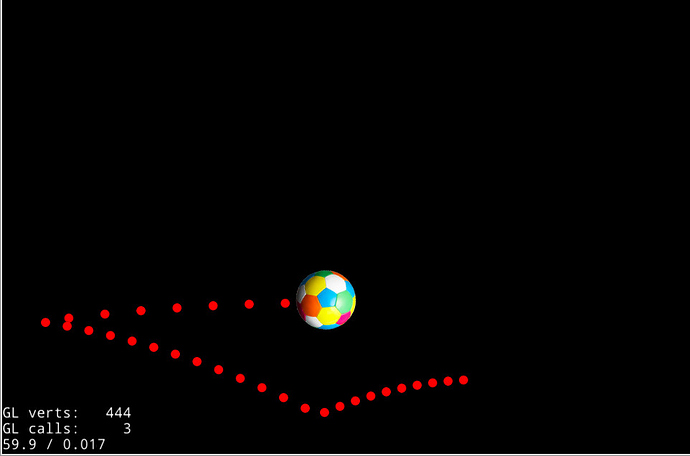Predict Trajectory with Cocos2dx 3 and Box2d
How to predict a trajectory with cocos2d-x and Box2d
GITHUB: GitHub - oldanidavide/trajectoryPredictionCocos2dx3: How to predict trajectory with cocos2dx and Box2D
Create a New Project
Create new cocos2d-x project with:
cocos new MyGame -p com.MyCompany.MyGame -l cpp -d ~/MyCompany
for more details check that page:
http://cocos2d-x.org/wiki/How_to_Start_A_New_Cocos2D-X_Game
NOTE: When you create a project with cocos-console, it make in your project dir, the folder cocos2d, i don’t have upload it because the size in MB it’s to big
Resources
Download the ball.png and dot.png and copy it in the Resources folder

![]()
Linux Version
open your project folder and in the file CMakeLists.txt add on line 161 ( on target link libraries ) the box2d
box2d
the result looks like that:
target_link_libraries(${APP_NAME}
ui
network
storage
spine
cocostudio
cocosbuilder
extensions
audio
cocos2d
box2d
)
Windows Version
Open your proj.win32 .SLN file and add Box2D dependency
Right click on Solution not project name then click on add, add exist project, search on external resources the BOX2D project and add it
Now right click on the solution, click property, select Project Dependencies and flag the libBox2D to compile.
Now right click on your project (inside the solution), and select reference, on the bottom, click ADD NEW REFERENCE then flag libBox2D, and click OK.
Click OK to close the windows
IT’S TIME TO CODE:
In HelloWorldScene.h file, on line 4 under #include "cocos2d.h" add:
USING_NS_CC;
and under public add:
bool onTouchBegan(Touch* touch, Event* event);
void onTouchMoved(Touch* touch, Event* event);
void onTouchEnded(Touch* touch, Event* event);
On the INIT main function add mouse event listener (example: HelloWorldScene.cpp )
//SET MOUSE LISTENER
auto listener = EventListenerTouchOneByOne::create();
listener->setSwallowTouches(true);
listener->onTouchBegan = CC_CALLBACK_2(HelloWorld::onTouchBegan, this);
listener->onTouchMoved = CC_CALLBACK_2(HelloWorld::onTouchMoved, this);
listener->onTouchEnded = CC_CALLBACK_2(HelloWorld::onTouchEnded, this);
_eventDispatcher->addEventListenerWithSceneGraphPriority(listener, this);
//END MOUSE LISTENER
In the main CPP file (HelloWorldScene.cpp) add the following function;
bool HelloWorld::onTouchBegan(Touch* touch, Event* event)
{
return true;
}
void HelloWorld::onTouchMoved(Touch* touch, Event* event)
{
}
void HelloWorld::onTouchEnded(Touch* touch, Event* event)
{
}
Inside INIT function add:
//CREATE A BALL
dragOffsetStartX = 0;
dragOffsetEndX = 0;
dragOffsetStartY = 0;
dragOffsetEndY = 0;
existBall= false;
ballX = 500;
ballY = 200;
ball =Sprite::create("ball.png");
ball->setPosition(CCPoint(ballX,ballY));
this->addChild(ball);
in the header (HelloWorldScene.h) file add:
Sprite *ball;
bool existBall;
float ballX;
float ballY;
int dragOffsetStartX;
int dragOffsetEndX;
int dragOffsetStartY;
int dragOffsetEndY;
b2Body *ballBody;
b2CircleShape ballShape;
b2BodyDef ballBodyDef;
void defineBall();
ADD A PHYSICS
Include in the header file the box2d library:
#include <Box2D/Box2D.h>
Add the b2ContactListener changing:
class HelloWorld : public cocos2d::Layer
to:
class HelloWorld : public cocos2d::Layer, public b2ContactListener
then add :
b2World *world;
float deltaTime;
Add in the INIT function the following line of code:
b2Vec2 gravity = b2Vec2(0.0f, -10.0f);
world = new b2World(gravity);
Where the -10.0f indicate the gravity on the y axis.
Now, we need to add a SCALE_RATIO. then define it at the top of the source with:
#define SCALE_RATIO 32.0
SCALE_RATIO indicate the value to convert pixel in meter, because BOX2D work with METERS.
In main source code (HelloWorldScene.cpp) add:
void HelloWorld::defineBall(){
ballShape.m_radius = 45 / SCALE_RATIO;
b2FixtureDef ballFixture;
ballFixture.density=10;
ballFixture.friction=0.8;
ballFixture.restitution=0.6;
ballFixture.shape=&ballShape;
ballBodyDef.type= b2_dynamicBody;
ballBodyDef.userData=ball;
ballBodyDef.position.Set(ball->getPosition().x/SCALE_RATIO,ball->getPosition().y/SCALE_RATIO);
ballBody = world->CreateBody(&ballBodyDef);
ballBody->CreateFixture(&ballFixture);
ballBody->SetGravityScale(10);
}
Call the function just after create a ball sprite, under the this->addChild(ball);
HelloWorld::defineBall();
Add an event to update the physics
In the header file add:
void update(float dt);
And in main cpp source add:
//Simulate Physics
void HelloWorld::update(float dt){
int positionIterations = 10;
int velocityIterations = 10;
deltaTime = dt;
world->Step(dt, velocityIterations, positionIterations);
for (b2Body *body = world->GetBodyList(); body != NULL; body = body->GetNext())
if (body->GetUserData())
{
CCSprite *sprite = (CCSprite *) body->GetUserData();
sprite->setPosition(ccp(body->GetPosition().x * SCALE_RATIO,body->GetPosition().y * SCALE_RATIO));
sprite->setRotation(-1 * CC_RADIANS_TO_DEGREES(body->GetAngle()));
}
world->ClearForces();
world->DrawDebugData();
}
Call the scheduleUpdate in the init function with:
scheduleUpdate();
If you try to start your application, you see the ball fall down
Now add a wall, to make our ball bouncing on it…
in the header file add:
void addWall(float w,float h,float px,float py);
in the main cpp file add:
void HelloWorld::addWall(float w,float h,float px,float py) {
b2PolygonShape floorShape;
floorShape.SetAsBox(w/ SCALE_RATIO,h/ SCALE_RATIO);
b2FixtureDef floorFixture;
floorFixture.density=0;
floorFixture.friction=10;
floorFixture.restitution=0.5;
floorFixture.shape=&floorShape;
b2BodyDef floorBodyDef;
floorBodyDef.position.Set(px/ SCALE_RATIO,py/ SCALE_RATIO);
b2Body *floorBody = world->CreateBody(&floorBodyDef);
floorBody->CreateFixture(&floorFixture);
}
and in the INIT main function add:
addWall(visibleSize.width ,10,(visibleSize.width / 2) ,0); //CEIL
addWall(10 ,visibleSize.height ,0,(visibleSize.height / 2) ); //LEFT
addWall(10 ,visibleSize.height ,visibleSize.width,(visibleSize.height / 2) ); //RIGHT
ADD POINT FOR TRAJECTORY
in the header file add:
Sprite *points[32];
and in the INIT main function add:
for (int i = 1 ; i <= 31; i++){
points[i] =CCSprite::create("dot.png");
this->addChild(points[i]);
}
ADD CONTROL
Remove the HelloWorld::defineBall(); calling previously in INIT method
Now inside the method onTouchBegan add:
dragOffsetStartX = touch->getLocation().x;
dragOffsetStartY = touch->getLocation().y;
CCPoint touchLocation = touch->getLocation();
ballX = touchLocation.x;
ballY = touchLocation.y;
if (existBall){
world->DestroyBody(ballBody);
}
ball->setPosition(ccp(ballX ,ballY));
Inside the method onTouchMoved add:
CCPoint touchLocation = touch->getLocation();
dragOffsetEndX = touchLocation.x;
dragOffsetEndY = touchLocation.y;
float dragDistanceX = dragOffsetStartX - dragOffsetEndX;
float dragDistanceY = dragOffsetStartY - dragOffsetEndY;
HelloWorld::simulateTrajectory(b2Vec2((dragDistanceX )/SCALE_RATIO,(dragDistanceY )/SCALE_RATIO));
Now we need to create the function simulateTrajectory function
Add in the header file:
void simulateTrajectory(b2Vec2 coord);
And in the main cpp source add:
void HelloWorld::simulateTrajectory(b2Vec2 coord){
//define ball physicis
HelloWorld::defineBall();
ballBody->SetLinearVelocity(b2Vec2(coord.x,coord.y));
for (int i = 1; i <= 31; i++){
world->Step(deltaTime,10,10);
points[i]->setPosition(CCPoint(ballBody->GetPosition().x*SCALE_RATIO,ballBody->GetPosition().y*SCALE_RATIO));
world->ClearForces();
}
world->DestroyBody(ballBody);
}
If you try the code, now we have a ball, in the “center” of the screen, and if you try drag the mouse, make a trajectory starting from ball.
THROW THE BALL
Now we need to add an onTouchEnded, go to the method and add:
existBall = true;
HelloWorld::defineBall();
CCPoint touchLocation = touch->getLocation();
dragOffsetEndX = touchLocation.x;
dragOffsetEndY = touchLocation.y;
float dragDistanceX = dragOffsetStartX - dragOffsetEndX;
float dragDistanceY = dragOffsetStartY - dragOffsetEndY;
ballBody->SetLinearVelocity(b2Vec2((dragDistanceX)/SCALE_RATIO,(dragDistanceY)/SCALE_RATIO));
ADD SIMPLE POWER
For add power at shooting just add a coefficient multiplier, add it on the header file:
float powerMultiplier;
set the power when create the ball adding:
powerMultiplier = 10;
then change the line:
HelloWorld::simulateTrajectory(b2Vec2((dragDistanceX )/SCALE_RATIO,(dragDistanceY )/SCALE_RATIO));
To:
HelloWorld::simulateTrajectory(b2Vec2((dragDistanceX * powerMultiplier)/SCALE_RATIO,(dragDistanceY * powerMultiplier)/SCALE_RATIO));
And the line:
ballBody->SetLinearVelocity(b2Vec2((dragDistanceX)/SCALE_RATIO,(dragDistanceY)/SCALE_RATIO));
To:
ballBody->SetLinearVelocity(b2Vec2((dragDistanceX * powerMultiplier)/SCALE_RATIO,(dragDistanceY * powerMultiplier)/SCALE_RATIO));
traj.jpg (27.8 KB)
ball.png (12.1 KB)
dot.png (2.9 KB)
HelloWorldScene.cpp.zip (2.0 KB)
HelloWorldScene.h.zip (0.8 KB)



